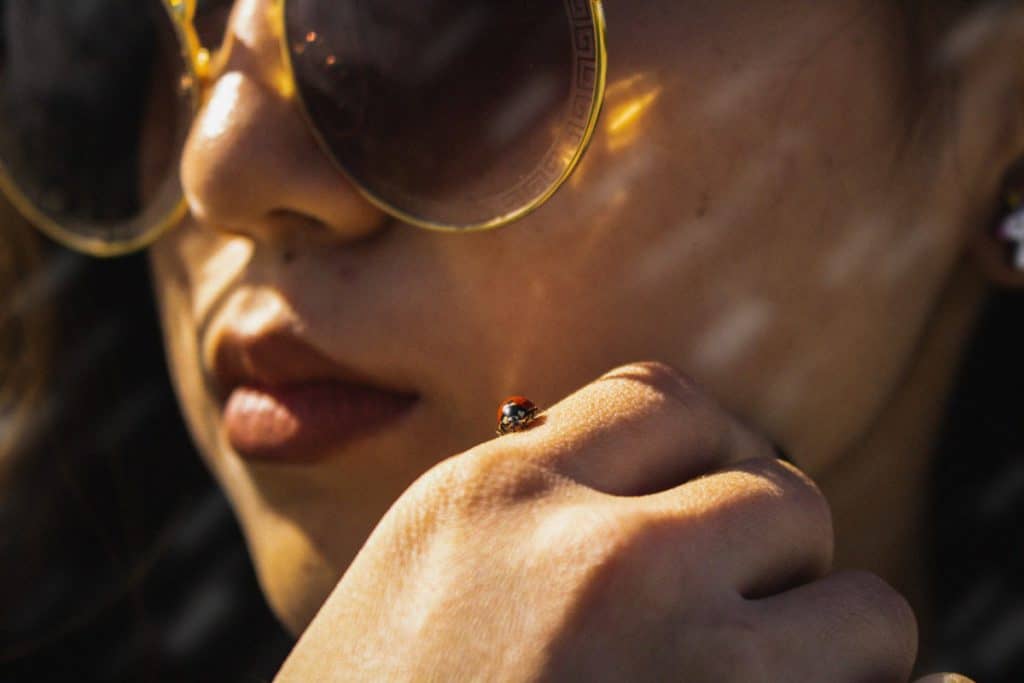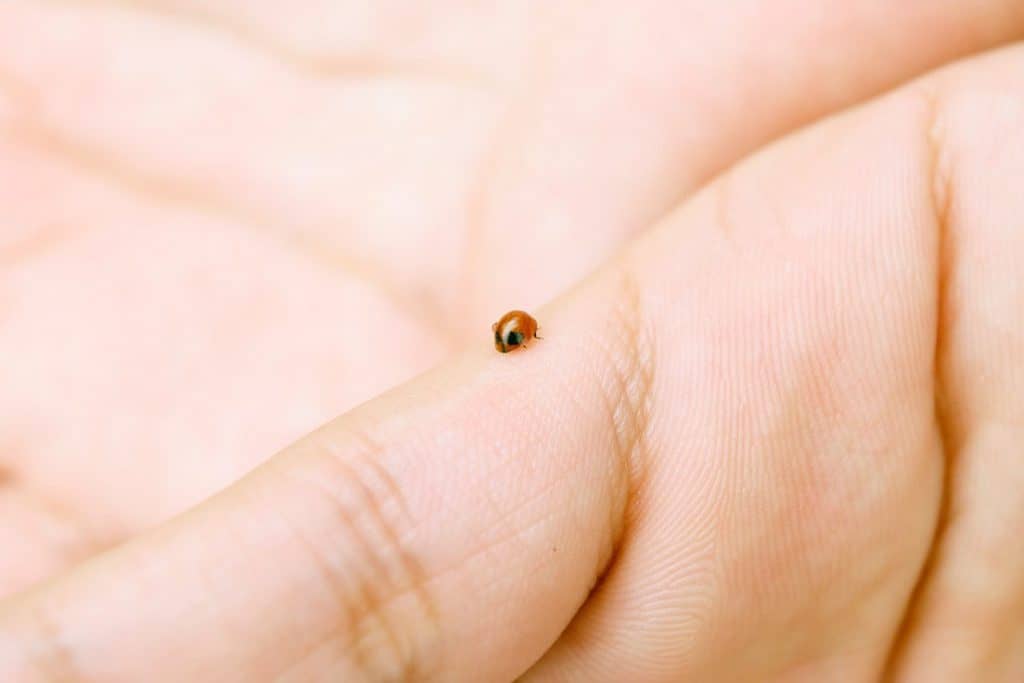
If you enjoy reading this article, why not check out our articles on The Color of Ladybugs – Explained and What Can Ladybugs Damage? The surprising answer
Ladybugs are such interesting insects, not only because of their colors but also the way they live. They may look cute to us, but ladybugs are also voracious monsters – they love to feed on aphids, which makes them a form of natural pest control.
Moreover, not only are ladybugs cute and useful, they also make great pets! You just have to make sure that their habitat is comfortable and you will meet their daily needs. Just like any pet that you may want to keep at home.
Can You Keep Ladybugs as Pets?
Yes, you can! However, it is important to make sure that you know the ins and outs of taking care of them inside your home. It is good to know what they eat, where to place them, and what their daily lives are like.
You can easily make a comfortable home for your pet ladybugs. This article will talk about the things that you can do to make sure that your ladybug will get the home that it deserves.
How to Catch a Ladybug
If you would like to keep a ladybug as a pet, you should know where to find and catch them.
Determining the location of where to get a ladybug is important. They are not hard to find if you have a garden nearby.
Ladybugs can usually be found clinging to leaves, blades of grass, and any other types of vegetation. They love staying in warm, moist areas just like fields, glades, and cultivation sites like gardens or farms.
In short, in order to find a ladybug, all you need to do is go outside on a warm sunny day, and look around. Wherever there is vegetation, there could be ladybugs too. Or, just walk around with a suitable container (such as a jar with holes poked in the lid for air) and be ready next time you randomly see a ladybug.
Pro tip: Ladybugs love to feed on aphids. If you see a plant that’s heavily infested with aphids, odds are there is already a ladybug around munchkin on them. And if there is not, the ladybug squad should show up eventually. So, when you see lots of aphids, ladybugs are never too far away.
When Is the Best Time to Catch a Ladybug?
The best time to go looking for ladybugs is during late spring and early summer. This is the time where everything is beginning to bloom. There is lots of food around and ladybugs come out to feed and eventually lay their eggs.
Once the weather starts to cool, ladybugs usually seek out warmth under rocks, hollow trees, and the opening of homes or structures.
During the summer, you could also happen to catch a ladybug larva (they look like tiny crocodiles). If you manage to do that, you’re in for a treat, as you can watch the larva turn into a ladybug.
Catching a Ladybug by Hand

Once you’ve found the location of where to get your ladybug, you would need to scoop it up gently by your hand. Most of the time, catching a ladybug is simply reaching out and plucking it from its hiding spot.
Once you have gotten the ladybug in your hand, make sure that you cradle it on your palm and form a ‘bowl’ with your fingers. This can prevent the ladybug to escape from your hand.
However, if you are worried that you might hurt the ladybug in your hand, you can rest your hand next to the surface where you found the ladybug and wait for it to crawl into your hand.
Be careful: You have to keep in mind that ladybugs are small and delicate creatures, so you have to make sure not to pinch, squeeze, or grip them too hard in your hands.
Collect Ladybugs Using a Net
Another technique that you may use to catch a ladybug is using a net. If you want to catch multiple ladybugs, then this is the best technique that you can use. Take a small butterfly net and slowly glide it along the edge of tall grass or leaves of plants.
Collect Ladybugs Using a Light Tent
If you plan to catch ladybugs at night, you can use a makeshift light tent. Prop a sheet of plywood, cardboard box, or similar flat surface against an exterior wall. Once you have found the perfect spot, place a white cloth on top of your plywood or cardboard box.
Plug a small floodlight or backlight in front of the covered board and leave it for a few hours. The ladybugs will begin to gather on the cloth, you can gently brush them off and put them in a small container.
Be Careful: Take note that UV light will draw curious ladybugs out of hiding just like it draws moths and other insects. The light tent will let you find out how many different types of bugs that are attracted to light live around your home. On the other hand, you will need to sift through all these bugs to find the ladybugs.
Safety Tips for You And Your New Ladybug Pet
Just like any other pets that you may have at home, there are different types of safety procedures that you should be aware of when you are taking care of a ladybug. And one of the things to keep an eye on is the ladybug’s defense mechanism. Yes, that’s a thing!
So let’s consider how ladybugs actually defend themselves from predators and how you can avoid triggering this response.
The Ladybug Defense Mechanism
A ladybug’s defense mechanism is to release a toxic fluid called hemolymph. This is a yellowish colored fluid that is naturally toxic. Ladybugs release this toxic fluid from the back of their bodies, as if to poop, so to say.
Interestingly, this defense mechanism is also called reflex bleeding, because this yellow liquid is actually the blood of a ladybug! However, the blood of insects is a lot different than that of humans, hence the weird look, the foul smell, and the toxicity.
Yes, the point of this phenomenon is to repel predators. The ladybug might hope to scare away any predators, such as lizards or birds, and potentially give them mild poisoning.
Don’t worry though, this liquid is definitely not poisonous for humans. Reportedly, it does taste awful and it can cause some numbness, but that’s not anything you should worry about.
But, if you notice your ladybug releasing yellow liquid, then you should know your new pet is stressed and feeling threatened, so next time try to treat it more gently.
Fun fact: Ladybug larvae can also ooze toxic alkaloids from their bodies.
To learn more about this chemical defense mechanism, check out our article Are Ladybugs Poisonous?
The Container for Housing Your Ladybug
The ideal size for a container is that it should be at least a square foot or bigger. Miniature terrariums and bug boxes are great to keep your ladybugs in. You could also use a large plastic food container that you rarely use.
Ladybugs love to fly and explore, so giving them a lot of space is a great idea. You need to also make sure that there are a lot of holes in your container that you can let enough air in without letting your ladybugs out.
However, don’t make the ladybug enclosure too big. Having a very big habitat will make it more difficult for the ladybug to find its food.
How to Make a Ladybug Habitat
When you’re keeping a ladybug as a pet, it is always a good idea to copy at least the same environment that they would get outside.
It is also wise to put some sticks, leaves, rocks, or even shells in their habitat so that they can have a place to hide. You can line the bottom of the container with materials that are natural in a ladybug’s habitat such as grass, leaves, or small stones.
Now, if you can’t find any natural structures, few small pieces of cardboard can do the trick. The cover can add obstacles for your ladybugs to have plenty of exercises daily. Just like a fish tank, it is always advisable to clean your ladybug’s habitat at least once a week.
Food For Your New Pet Ladybugs
In their natural habitat, ladybugs usually eat aphids that can be found on plants. However, there are other things that you can feed your ladybugs at home.
When feeding your ladybug, you have to consider their size, as well as the species. There are over 3000 species of ladybugs. While most of them like to eat smaller insects (primarily aphids), some are actually herbivores, although that’s quite rare.
The easiest way to find out what your ladybug likes to eat is to try a few different things and observe how it responds.
Feeding Portions for Ladybugs
Too much feeding is not recommended since it may kill your ladybug. It is always nice to feed your ladybug in a small container like a bottle cap. Feeding them twice a day is enough for them to survive.
But, also keep in mind that ladybugs can eat a lot considering their size. In nature, they can eat up to 50 aphids a day if they are available.
For more information on what ladybugs eat, take a look at What Do Ladybugs Eat? Lets Find Out.
Here are some of the food that you can give them daily.
Lady’s Favorite Fruits
Some people may think that feeding ladybugs fruits or anything sugary is dangerous for them. However, this is not the case. It is safe for them to eat fruits as long as it is non-acidic. Their favorites are fruits that have high sugar content.
Some examples of fruits that you can give your ladybugs are bananas, dates, figs, grapes, papaya, and persimmons. However, their favorite fruits are grapes and raisins because of their high sugar content.
There are also some low acidic fruits that you can provide such as apples, blackberries, blueberries, cherries, grapes, nectarines, peaches, pears, plums, and raspberries. The safest food that you can give to your ladybugs is rehydrated apricots and strawberries.
Vegetables to Keep Her Healthy

There are a lot of ladybug species that you might catch along the way. Some of them are vegetarian and only feed on leaves. You can feed your ladybugs lettuce and cucumbers, however, it is only advisable to feed vegetables temporarily.
You can only feed them lettuce or cucumbers if there is no other food that you can feed them. You can call this the ‘emergency food’ for your ladybugs. It is still advisable to give them their daily food such as aphids and other soft-bodied insects.
The Yummiest Insects
As mentioned above, the number one food that you can feed your ladybug is aphids. It is their most favored meal. There are a few places where you can get aphids such as pet stores or on Amazon.
Now, if you do not want to spend any money, you can always go in your backyard and scoop up some aphids that you can find on your plants. Other insects that they eat are spider mites, mealybugs, and plant lice.
Aphids are tiny and can be difficult to catch, but if you see a plant that’s heavily infested by aphids you can simply snip off a leaf full of aphids and place it into your ladybug enclosure.
It is still advisable to buy aphids in pet stores or online because it may be hard to find and catch them in your backyard.
Water and Drinks for Your New Pet
Water and honey is the best drink for your ladybug pet. However, there is a correct process on how you can provide water to them. The best technique is to place it on a damp paper towel or sponge for your ladybug to drink.
Ladybugs do not drink much water so a damp paper towel or sponge is enough to last them for seven days. Make sure that you check your water source every couple of days and re-wet it once it feels dry.
You should not leave a pool of water in your ladybug’s habitat since they might drown. An alternative technique that you can use is to fill a spray bottle with clean water. Once you have done so, you can spray the walls of your habitat daily.
The thin layer of moisture is great for your ladybugs to stay hydrated.
Conclusion
A ladybug can live up to one year. Most of the things that they do in their daily lives are flying around and feeding on plant pests. This is the reason why they are called a gardener’s or farmer’s best friend. So, if you are having problems with aphids in your garden, you might as well decide to release your ladybug pet to help you. After all, these insects thrive in the open spaces outdoors.
In any case, these are the main tips to remember if you decide to keep a ladybug as a pet:
- Keeping ladybugs in your home will be a big responsibility. Learning how to feed them properly and keeping their habitat comfortable for them is important for them to live.
- You can feed them fruits if you do not have easy access to soft-bodied insects such as aphids. Make sure that you do not feed them any acidic fruits since this can be bad for them.
- Getting a container where they can move freely is another important thing to remember.
- It is your choice if you want to release them during spring. However, it is advisable to do so since they belong outside. Now, you can confidently say that you can take care of ladybugs in your home!
If you enjoyed reading this article, why not check out our articles on Are Ladybugs Poisonous? and What Can Ladybugs Damage? The surprising answer
Recent Posts
Tiny Black Bugs in Bathroom NO WINGS: What They Are and What to Do!
Finding tiny black bugs in your bathroom can be uncomfortable, to say the least. Especially if they are persistent, or they appear in very large numbers, which they often like to do. When it...
Tiny Black Bugs in Plant Soil - What Are They & What To Do About It
A short horror story: You get a new houseplant. You do your best to take care of it. You’ve ensured that it has the right soil, the right amount of sun, it gets enough water. And then one day, you...

